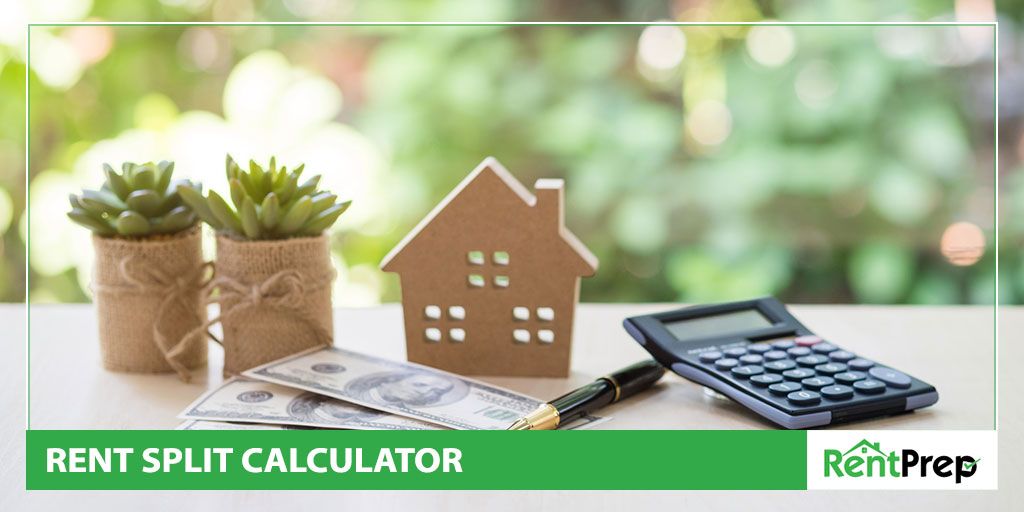
Once you sign a lease with your tenants, how they decide to split the rent between them is out of your hands. However, it’s good practice as a landlord to be aware of the tools tenants may use and what troubles they might encounter. One tool worth knowing more about is a rent split calculator.
Some of your tenants may have roommates, or you might rent a property out to cotenants with individual leasing terms. Regardless, the conversation about how rent should be split or divided may come up. While you’re unlikely to be part of that decision, you can give your tenants the tools they need to stay on top of their rent.
Rent calculators split the rent according to various factors, and there are a few types of rent splitting calculators. Let’s learn more about them today.
Table Of Contents On Rent Splitting Calculators
Rent splitting is typically handled between tenants or roommates, but understanding how they work can help you be in touch with how your tenants handle their rent. This knowledge will give you an edge if any rent issues arise, and it’ll also enable you to be a more helpful resource for your tenants.
- What Is A Rent Split Calculator?
- Different Ways To Split Rent
- Necessary Agreements When Splitting Rent
- Determining How You Collect Rent
- Rent Split Calculator FAQs
- The Lease Agreement Is Key
What Is A Rent Split Calculator?

A rent split calculator is a tool that allows individuals to quickly determine how much rent each occupant should pay when sharing a single unit. Rent split calculators make it possible for roommates and cotenants to decide how to divide rent and easily see the exact amounts each person should contribute.
Tenants who allocate their rent in fair and proportionate ways are less likely to get into financial disagreements and more likely to pay their rent on time. There are many free rent split calculators online that can simplify this process.
There are a variety of ways to divide rent, and it’s crucial for those sharing space and financial responsibility to divide things clearly. This prevents misunderstandings or conflicts that lead to missed rent, and that’s a massive benefit for you as a landlord.
Even if you ensure that all tenants are named on the lease, they might not all pay the same amount toward the rent. Most landlords require all occupants to be cotenants, equally responsible for the entire rental cost, but most cotenants will divide that cost among themselves.
How Do Rent Split Calculators Work?
Rent split calculators may consider various factors whenever determining each rental share. For example, the occupant with an ensuite bathroom may pay more than those who share a bathroom.
Some factors that a rent split calculator will use to determine rent shares include:
- Property square footage
- Total rent cost
- Each occupant’s share of square footage
- Ensuite versus communal bathrooms
- Total number of occupants
By using all of these terms, cotenants may find a way to share rent that is agreeable to everyone and less likely to be imbalanced. Some calculators even give a percentage-to-pay amount, which can then be applied to utilities.
Different Ways To Split Rent
Multi-tenant units will have multiple occupants, and most of those occupants will be paying a share of the rent. Some tenants might ask for advice about splitting rent fairly or how tenants usually split rent. While it’s not your decision to make, you can tell them about splitting rent calculators.
However, when doing this, be aware that there are different ways to split rent. Each method works best for specific situations, so cotenants need to use a suitable calculation method for their situation.
#1: Room By Room
This is the most straightforward way to calculate rent split. By taking the total monthly rent and dividing it by the number of bedrooms, you can determine how much should be paid for each bedroom.
This method is most useful when there is one occupant in each bedroom, and each bedroom provides similar space, amenities, and access to communal areas. Everybody will likely find this splitting method fair and agreeable if everything is close in size.
This method is not as useful when a couple is living in one of the rooms, or the living situation is otherwise uneven. Dividing rent can be more difficult in that type of situation. Still, this method is best for single renters that share communal spaces relatively equally.
#2: Total Space
In many rental situations, the living space is not evenly divided. Some units are made up of single rooms and ensuite master bedrooms. Even if cotenants are happy to share rent, the person occupying the single room is unlikely to want to pay the same amount for less space.
In these situations, rent split calculators are great for assigning rent according to proportion.
Tenants will need to calculate the square footage of all personal spaces. Then, divide each individual’s space by the total space. Multiply this number by the total monthly rent to determine how much each individual should pay.
This method of splitting rent is ideal when spaces vary significantly in size or when the cotenants aren’t very close. Dividing by size is less likely to cause disagreements in these situations since everyone will feel that things are balanced.
#3: Monthly Income
A less common method of splitting rent is to use a rent split calculator to divide rent based on income. This enables occupants to support each other based on what they can afford without putting too much strain on any one person.
This method is best for close friends, related tenants, or those otherwise committed to this type of communal support. The individual making more money will pay more, and that’s not something that all cotenants will agree to. However, some find this type of community support ideal and want to try it.
#4: Number Of Tenants
Some co-tenants prefer to keep things simple and divide the total rent by the total number of occupants at any given time. This can be good for couples sharing space with single individuals to ensure that everyone is equal in their contribution.
This can also be a good solution if there are private spaces that are shared by some tenants, such as a bedroom that isn’t rented but used as shared office space. Ultimately, everyone is paying to use all of the accessible areas equally.
#5: Amenities
Finally, some rent splitting calculators will allow you to designate which tenants have additional amenities or perks. Many things could be considered a perk, from balcony access to a private parking space.
Designating what is and what is not worth more must be agreed upon by all parties, and that is one of the reasons that this type of rent division is not used as frequently as the others.
Necessary Agreements When Splitting Rent

If your tenants talk to you about splitting rent, remind them that they are each fully responsible for the lease agreement they signed with you. However, you can advise them to make sure they have some type of written roommate agreement to hold each other accountable for any verbal agreements made.
Even with friends, living together and sharing financial responsibility can create strain. Tenants with roommate agreements are more successful as cotenants, which is good for you as they are less likely to end their lease early or miss rent payments.
Most roommate agreements include the following information:
- How household duties are shared
- How utilities are paid
- How rent is divided and paid
- How food and kitchen use is shared
- Rules on noise, overnight guests, parties
- Process for dealing with disagreements
- How the security deposit will be handled
Outlining all of this in a roommate agreement is sure to make cotenants in all your rental units happier, so we always advise encouraging these types of agreements to tenants.
Determining How You Collect Rent
The primary thing you need to worry about as a landlord regarding rent splitting is how you will be paid.
If cotenants are dividing rent, that is fine, but you should know how you will be getting that payment. Cotenants may request to make separate payments so they won’t need to transfer money to each other. Accepting this request is up to you, but you should always remind tenants that they are equally responsible for the lease agreement if their roommate doesn’t pay on time.
Some landlords prefer only to receive one payment per month as it makes the bookkeeping process more straightforward. Encourage tenants to determine who will pay rent, how they will pay it, and make sure to get that payment in on time to avoid late fees. If they are late, you may want to use a partial payment agreement to get them back on track without forfeiting your rights.
If you use a management platform, check to see if there are any options for collecting separate payments. You might be able to bill each tenant individually, which will ensure easy rent collection.
Keeping Your Business In Line
With all this talk of splitting rent and rent collection, you may be worried about cotenants or roommate situations being unnecessarily complicated. However, it’s common for rental units to be occupied by multiple individuals and for them all to be involved in the leasing process.
Your lease agreement should be the bottom line that you use to keep things in order, and you will want to be sure that your lease agreement is thorough. If you’re just getting started as a landlord and feeling overwhelmed, check out RentPrep’s Landlord Starter Form Kit.
Start utilizing this essential kit today to keep yourself calm, collected, and organized as you venture into the rental business.
Rent Split Calculator FAQs
Why are rent split calculators different?
Some rent split calculators calculate rent by the number of occupants, while others divide it based on factors like square footage or amenities. Tenants should be sure their chosen calculator matches their splitting preferences.
Can tenants split rent based on income?
Yes. If tenants decide to split rent based on income, they can use a percentage-based model to determine who pays what. To make this easier, you can suggest they use a rent split calculator that will help determine the exact amounts without needing to do the math themselves.
Who pays the landlord when splitting rent?
Tenants can decide who pays you when splitting rent, or you can accept rent from all parties. Make sure that everyone involved is clear about who holds responsibility for unpaid rent and what will happen if one tenant doesn’t pay.
Can someone leave a co-tenancy agreement?
All co-tenancy lease agreements should have clear terms on what will happen if someone decides to move out early. In most cases, that individual still fully shares the responsibility until they are replaced, but leaving the agreement altogether may be difficult. Ultimately, whether or not it is possible will depend on the language used in the lease agreement.
Check your documentation for the terminology to decide your next steps, and be sure to communicate with all tenants along the way to have the best understanding of their needs.
The Lease Agreement Is Key
While it’s essential for you as a landlord to learn more about splitting rent calculators and other tools that tenants are using to manage their finances, your primary guide will always be the lease agreement.
Ensure that all cotenants are on the lease and that you have a clear policy about roommates and additional occupancy. If these rules are unclear, you could be left with tenants without leases and unable to collect rent.
Advise your tenants on methods they can use to manage their rent division but stay out of the actual division process. Your job as a landlord is to collect rent, not decide how your tenants divide it. Keeping that boundary clear will be better in the long run.

